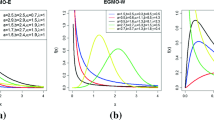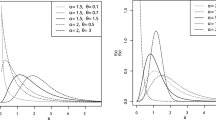Abstract
In this paper, we introduce a generalized mixture distribution, so-called the binomial mixture Lindley distribution (BMLD). The density function of this distribution is obtained by mixing binomial probabilities with gamma distribution. BMLD have various distributions as its special cases and posses various shapes for its hazard rate function including increasing, decreasing, bathtub shape and upside down bathtub shape depending on its parameters. Several mathematical, structural and statistical properties of the new distribution is presented such as moments, moment generating function, hazard rate function, vitality function, mean residual life function, inequality measures, entropy and extropy etc. The parameters of the model are estimated using the method of maximum likelihood and finally real life data sets are considered to illustrate the relevance of the new model by comparing it with some other lifetime models.






Similar content being viewed by others
References
Aarset MV (1987) How to identify a bathtub hazard rate. IEEE Trans Reliab 36(1):106–108
Abouammoh AM, Alshangiti AM, Ragab IE (2015) A new generalized Lindley distribution. J Stat Comput Simul 85(18):3662–3678
Al-Mutairi DK, Ghitany ME, Kundu D (2013) Inferences on stress-strength reliability from Lindley distributions. Commun Stat Theory Methods 42(8):1443–1463
Bjerkedal T (1960) Acquisition of resistance in guinea pies infected with different doses of virulent tubercle bacilli. Am J Hyg 72:130–148
Bhati D, Malik MA, Vaman HJ (2015) Lindley-exponential distribution. Properties and applications. METRON 73(3):335–357
Bonferroni CE (1930) Elementi di statistica generale. Seeber, Firenze
Deniz EG, Ojeda EC (2011) The discrete Lindley distribution properties and applications. J Stat Comput Simul 81:1405–1416
Ebrahimi N (1996) How to measure uncertainty in the residual life time distribution. SankhyÄ Indian J Stat Ser 5:48–56
Elbatal I, Merovci F, Elgarhy M (2013) A new generalized Lindley distribution. Math Theory Model 3(13):30–47
Ghitany ME, Alqallaf F, Al-Mutairi DK, Husain HA (2011) A two-parameter weighted Lindley distribution and its applications to survival data. Math Comput Simul 81(6):1190–1201
Ghitany ME, Atieh B, Nadarajah S (2008) Lindley distribution and its applications. Math Comput Simul 78:493–506
Havrda J, Charvát F (1967) Quantification method of classification processes. Concept of structural a-entropy. Kybernetika 3(1):30–35
Lad F, Sanfilippo G, Agro G (2015) Extropy. Complementary dual of entropy. Stat Sci 30(1):40–58
Lai CD, Xie M, Murthy DNP (2003) A modified Weibull distribution. IEEE Trans Reliab 52(1):33–37
Lemonte AJ, Cordeiro GM, Ortega EM (2014) On the additive Weibull distribution. Commun Stat Theory Methods 43(10–12):2066–2080
Lindley DV (1958) Fiducial distributions and Baye’s theorem. J Roy Stat Soc B 20:102–107
Mazucheli J, Achcar JA (2011) The Lindley distribution applied to competing risks lifetime data. Comput Methods Programs Biomed 104(2):188–192
Nadarajah S, Bakouch HS, Tahmasbi R (2011) A generalized Lindley distribution. Sankhya B 73(2):331–359
Pal M, Ali MM, Woo J (2006) Exponentiated weibull distribution. Statistica 66(2):139–147
Qiu G, Jia K (2018) The residual extropy of order statistics. Stat Probabil Lett 133:15–22
Ranjbar V, Alizadeh M, Altun E (2019) Extended Generalized Lindley distribution: properties and applications. J Math Ext 13:117–142
Rényi A (1961) On measures of entropy and information. Proc Fourth Berkeley Symp Math Stat Probabil 1:547–561
Shanker R, Sharma S, Shanker R (2013) A two-parameter Lindley distribution for modeling waiting and survival times data. Appl Math 4(2):363–368
Sharma VK, Singh SK, Singh U, Agiwal V (2015) The inverse Lindley distribution: a stress-strength reliability model with application to head and neck cancer data. J Ind Prod Eng 32(3):162–173
Shannon CE (1948) A mathematical theory of communication. Bell Syst Tech J 27(3):379–423
Smith RL, Naylor JC (1987) A comparison of maximum likelihood and Bayesian estimators for the three parameter Weibull distribution. J R Stat Soc Ser C 36(3):358–369
Titterington DM, Smith AFM, Markov UE (1985) Statistical analysis of finite mixture distributions. Wiley, New York
Tsallis C (1988) Possible generalization of Boltzmann-Gibbs statistics. J Stat Phys 52(1–2):479–487
Zakerzadeh H, Dolati A (2009) Generalized Lindley distribution. J Math Exten 3:13–25
Zenga M (2007) Inequality curve and inequality index based on the ratios between lower and upper arithmetic means. Statistica Applicazioni 4:3–27
Acknowledgements
The authors express their gratefulness to the learned referee for many of the constructive comments and suggestions, which lead the way to improvements and thus procure current version of the paper. First author acknowledge the Cochin University of Science and Technology for providing financial support in the form of seed money for new research initiatives (No.PL.(UGC)I/SPG/SMNRI/2018-2019).
Author information
Authors and Affiliations
Corresponding author
Additional information
Publisher's Note
Springer Nature remains neutral with regard to jurisdictional claims in published maps and institutional affiliations.
Appendix
Appendix
The second partial and cross derivatives with respect to the parameters are derived as,
and
Rights and permissions
About this article
Cite this article
Irshad, M.R., Shibu, D.S., Maya, R. et al. Binominal Mixture Lindley Distribution: Properties and Applications. J Indian Soc Probab Stat 21, 437–469 (2020). https://doi.org/10.1007/s41096-020-00090-y
Accepted:
Published:
Issue Date:
DOI: https://doi.org/10.1007/s41096-020-00090-y




